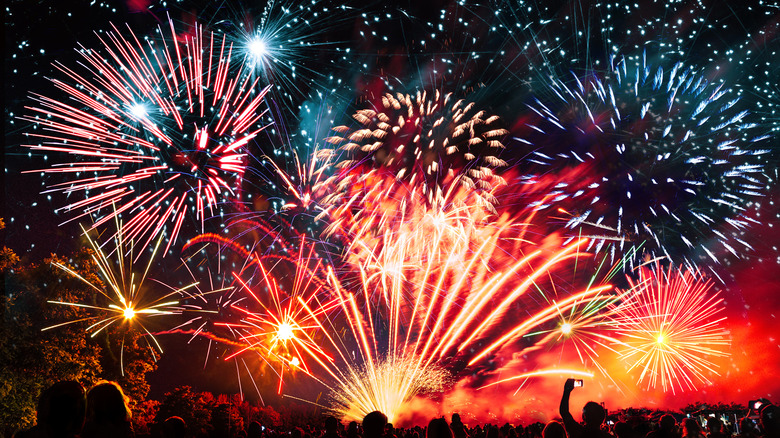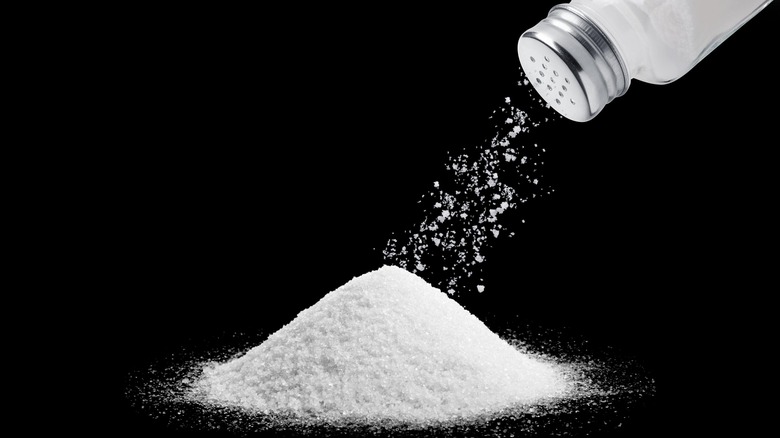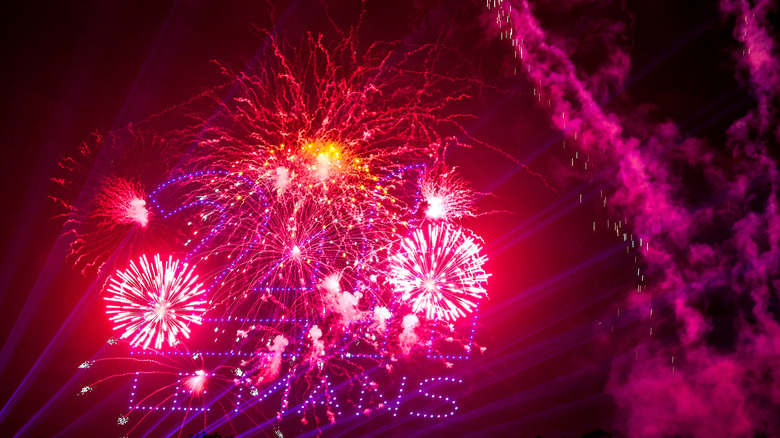What Really Makes Fireworks Different Colors
Without a doubt, fireworks are one of the world's favorite tools of celebration. New Year's Eve fireworks show up in countries like the U.A.E., Australia, and the Netherlands. Japan has fireworks celebrations throughout the year, but especially in the summertime. The U.K. sends up fireworks on Guy Fawkes Day, and France on Bastille Day. The U.S. has fireworks bonanzas on July 4, Independence Day. And of course, nothing is stopping anybody from grabbing ahold of some backyard explosives on any random weekend of the year, particularly come barbecue time. That is unless local law prevents you from doing so. Also, don't blow your hand off by accident, please.
But even though it's easy and fun to set off fireworks — and a bit thrilling — it might not be as easy to explain how they work. We jokingly called them "explosives," but is that what they are? If so, what makes them shoot in the air and not just explode like a bomb? And where do all the pretty patterns and colors come from?
As it turns out, understanding fireworks requires understanding something that many people might not have thought about since 10th grade: chemistry. As EarthSky says, fireworks get their colors from a simple source: salt. The kind of salt that people often eat — sodium — produces yellow fireworks. Calcium salt produces orange, copper salt produces blue, etc. As for details of the chemical differences and what other ingredients go into making fireworks we've got to dive deeper.
Different salts for different colors
Some folks might be wondering if by "salt" we mean the stuff you've got on a shelf in the kitchen that you add to canned tomatoes when making homemade pasta sauce. Delicious Italian digressions aside, the answer is actually yes. This doesn't mean that you can just grab a handful of white crystals and toss them on an open flame to have your own personal Fourth of July fireworks bash. It's a bit more complicated than that. That's a good thing, or else cooking time might get a whole lot more obnoxious and colorful than it needs to be.
When most people say salt they mean one specific type of salt: sodium chloride, aka table salt. Sodium chloride (NaCl) is 40% sodium (Na) and 60% chloride, or negatively-charged chlorine (Cl), as the Harvard School of Public Health says. Sodium chloride might hold a special place in our hearts — literally — and on our palates, but it's just one type of salt. Salt, in a general chemical sense, is a type of charged compound that forms crystals when dried.
People use different salts every day without realizing it. As ReAgent says, calcium carbonate deices roads in winter. Sodium bisulphate reduces the pH level of swimming pools, while ammonium dichlorate helps develop photographs. Sodium bicarbonate, commonly called baking soda, goes in pancakes to make them fluffy and also into fire extinguishers to put out fires. Only certain kinds of salt go in fireworks to produce different colors.
A lot of work, a lot of chemistry
Compound Interest has a handy breakdown of each color firework and the specific kind of chemicals that produce them. Sodium produces yellow, strontium creates red, calcium gives you orange, barium makes green, copper begets blue, and for those who remember their color wheel, red and blue make purple. Within each of these elemental groups there are different metal and non-metal elements and ions (charged particles) that produce the same color. Red fireworks, for instance — the strontium ones — can come from strontium nitrate, strontium carbonate, and strontium sulfate. White comes from magnesium, aluminum, or titanium, while silver comes from a super hot mixture of magnesium and aluminum.
We need to go through all of this chemical labor just to make the colors for fireworks, to say nothing of other ingredients and how to construct the whole thing. Fireworks use gunpowder for fuel, which requires convoluted chemistry to create, as Compound Interest shows. Fireworks also need a binder — a substance to hold the other compounds together — which is usually dextrin. Oxidizers add fuel to the explosion, and chlorine donors — compounds rich in chlorine — amplify the colors. Imperial College London shows us how it all ties together. An initial charge shoots a fuse (the thing that explodes) out of a tube and causes it to heat up on its way into the sky. When the fuse gets hot enough, everything inside goes boom. Cue the holiday memories and "oooooohs" and "aaaaaahs" from folks below.


